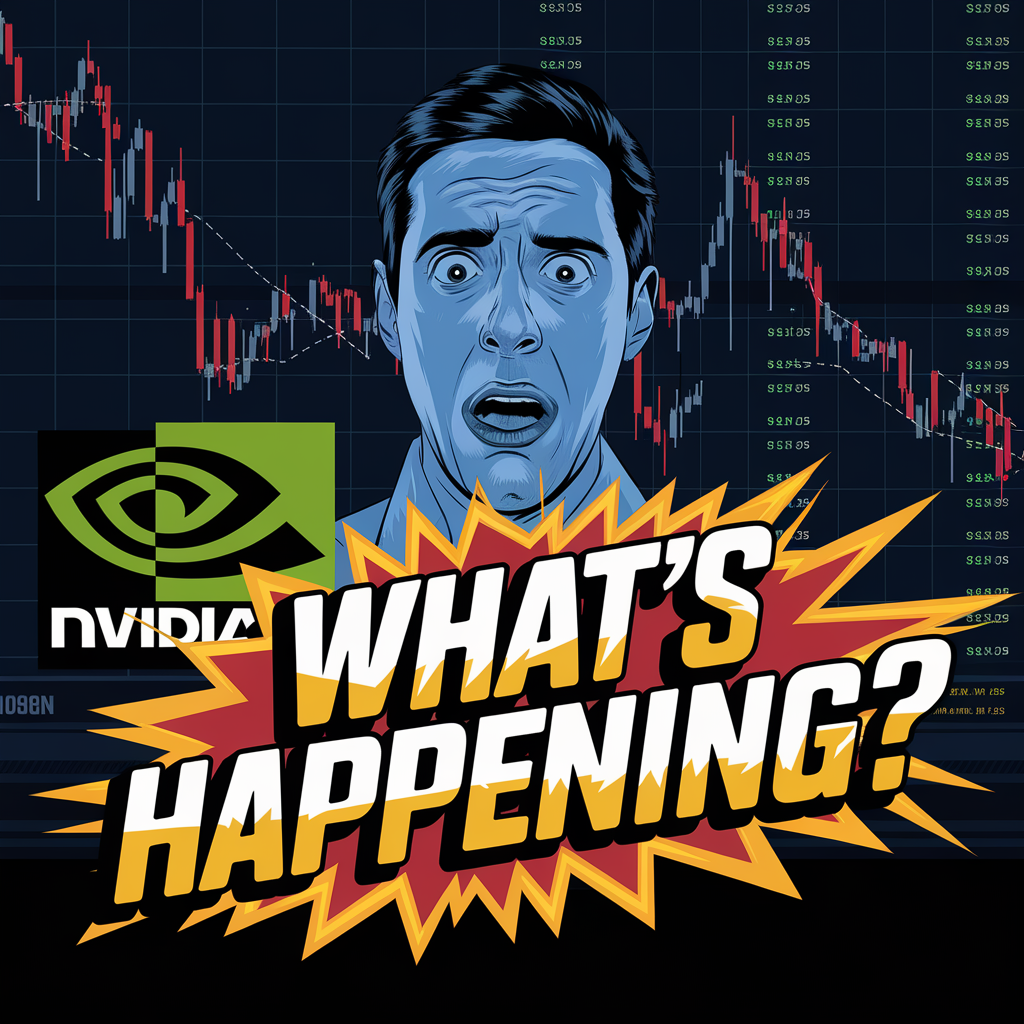If you’ve been following the stock market lately, you might be feeling a bit uneasy about the recent sudden drops in NVIDIA´s share prices. As a beginner investor, it’s natural to wonder what’s causing this volatility and whether you should be worried. Likewise, it´s a time when many are asking the question “should I invest in NVIDIA” or pondering if now is a good time to invest.
In this article, we’ll dive into the reasons behind the recent events and explore what the future might hold for this AI giant and whether as a retail or beginner investor you should be concerned about those red numbers!
NVIDIA – An overview of the AI Giant
To made an educated assessment to the current, and indeed the future it´s important that we reflect on the past. NVIDIA Corporation (NASDAQ: NVDA) has been a trailblazer in the technology industry for nearly three decades. These guys are in no way the new kids on the block!
Before I go on, this new blog is a personal little project whereby I try to bring the world of business and investing into plain simple English. Please do signup for a free newsletter (there´s no cost for the blog and I am not affiliated to anyone mentioned in this post) and get easy to digest market news and views.
Founded in 1993, NVIDIA has revolutionized the gaming, professional visualization, data centre, and automotive markets with its innovative graphics processing units (GPUs) and artificial intelligence (AI) solutions. Going back to when everyone was worried about the millennium bug (that makes me feel old), I was in the IT sector and distinctly recall NVIDIA being the unrivalled name for anything that involved gaming and graphics. Incidentally, even back then I favoured AMD over Intel (for various reasons) and look at them today! But that´s another story I may ramble on about another day! Over the years, NVIDIA’s products have become essential components in a wide range of applications, from gaming consoles and personal computers to self-driving cars and supercomputers.
To put NVIDIA’s size into perspective, the company’s market capitalization (the total value of its outstanding shares) briefly surpassed $3 trillion in June 2024, making it the third most valuable company in the world, behind only Apple and Microsoft. NVIDIA’s annual revenue in fiscal year 2024 was a staggering $30 billion. That´s a lot of lollipops!
NVIDIA´s Recent Earnings and Market Expectations
On August 28, 2024, NVIDIA reported its second-quarter fiscal 2025 earnings, which beat market expectations. The company posted record quarterly revenue of $30.0 billion, up 15% from the previous quarter and 122% from the same period last year. So, you may well be wondering (and with very valid reason) how, despite these impressive numbers, NVIDIA’s stock price fell by 9.5% the following day, wiping out $279 billion in market value.
This seemingly counterintuitive market reaction can be attributed to the high expectations and speculation surrounding NVIDIA’s growth as I predicted in a previous post. Investors have been pricing in the company’s potential to dominate the AI chip market, and any signs of slowing growth or missed “whisper numbers” (unofficial earnings expectations) can trigger a sell-off, often our of panic, sentiment or opportunity seeking traders. Additionally, concerns about the company’s gross margin, which slightly decreased from the previous quarter, may have contributed to the negative sentiment.
The Broader Economic Picture (get it?, “Picture”, graphics cards..) never mind!
It’s crucial to understand that NVIDIA’s stock performance is not occurring in a vacuum. The overall market has been experiencing a downturn, with the S&P 500 and Nasdaq Composite both falling on the first trading day of September. As one of the largest components of these indices, NVIDIA’s price movements have a significant impact on the broader market.
Moreover, the recent earnings season has revealed mixed results across various sectors, with many companies providing cautious guidance amid economic uncertainty. Investors are also closely watching the upcoming U.S. employment figures and the potential for an interest rate cut by the Federal Reserve (potentially following the UK´s recent rate reduction) both of which could influence market sentiment.
Insider Selling and Market Speculation

Another factor contributing to the recent volatility in NVIDIA’s stock price is the news of insider selling. CEO Jensen Huang and other executives have sold a portion of their holdings, which has raised concerns among some investors. However, it’s important to note that selling shares is a common practice for executives looking to diversify their portfolios or lock in profits. Despite the recent sales, Huang still holds a significant stake in the company.
In addition to insider selling, various news and rumours can affect NVIDIA’s stock price. For example, reports of a subpoena from the U.S. Department of Justice regarding a potential antitrust investigation have added to the uncertainty surrounding the company. Even if these allegations prove to be unfounded, the mere speculation can cause short-term fluctuations in the stock price as traders react to the news. Perhaps it´s a good time to point out that these types of things actually are far more common than you would think – but they only make the headlines when it´s companies this big. There are however always legal things ongoing in many companies so I am personally not too worried right now about this news, especially in the short term and these early stages.
NVIDIA Valuation and Growth Trajectory
Over the past year, NVIDIA’s stock price has grown by an astonishing 125%, far outpacing the average market growth and inflation rates. While this growth has been driven by the company’s strong performance and the increasing demand for AI solutions, some analysts have argued that a correction is inevitable. Let´s be honest, no company can keep growing at that rate forever and at some point. It’s not sustainable in the long term. As the company matures and faces increased competition, its growth rate will likely moderate. However, this does not necessarily mean that NVIDIA is a necessarily a poor investment; rather, it suggests that investors should adjust their expectations and consider the company’s long-term prospects – perhaps it´s time to wake up and be realistic!
The Future of AI and NVIDIA’s Position
Despite the recent volatility, I believe that NVIDIA remains well-positioned to benefit from the growing demand for AI solutions. The company’s cutting-edge GPUs and software platforms, such as the upcoming Blackwell architecture (which has had reported delays but is reported to be well into production and to be generating real income this year), give it a significant competitive advantage in the AI chip market.
Furthermore, NVIDIA’s partnerships with major technology companies and its expansion into new markets, such as autonomous vehicles and robotics, provide additional growth opportunities. As AI continues to transform various industries, NVIDIA’s expertise and market leadership will likely prove valuable.
That being said, it´s been reported that almost half of the massive revenues of NVIDIA in recent filings was reported to have come from four customers. This accounted for 46% ($13.8 billion) of Nvidia’s total Q2 revenue. Now, whilst that can be taken as a good that it has some seriously big clients, investors are often (quite rightly) cautious when a significant amount of a company´s revenue comes from a small number of sources so it is an important consideration to keep in mind when assessing the overall performance and risks related to revenue streams.
Political Landscape and Supply Chain Dynamics
The upcoming U.S. elections in November 2024 could have a significant impact on the stock market, depending on the outcome. Changes in government policies, trade relations, and regulatory environments can all affect companies like NVIDIA.
Another important development to watch which I find interesting and quite frankly exciting is the planned partnership between Taiwan Semiconductor Manufacturing Company (TSMC), a major supplier to NVIDIA, and others to open a massive operation in the EU. This is reported to be backed by the EU and German governments which will not only be an amazing opportunity for Germany and the EU but in my view could help NVIDIA diversify its supply chain and mitigate potential risks associated with U.S.-Taiwan trade relations. Additionally, existing trade agreements between the European Union and the United States may provide more predictable supply chain cost planning for NVIDIA.
Were do I stand on the subject?
I recently felt in my gut that the stock price would experience a slight drop following the earnings report before gradually stabilizing around $130-150 per share. While the recent external factors have caused further declines than I thought, I maintain my belief that the stock will recover, albeit at a slower pace.
The remainder of 2024 will be crucial for NVIDIA to demonstrate the success of its Blackwell architecture and prove its ability to generate the earnings it has projected. If the company can meet or exceed its guidance and showcase the real-world impact of its new technologies, I believe that 2025 could see the stock price establish a new baseline for growth. I remain confident in NVIDIA’s long-term prospects. However, I think that 2025 may be a year when many rethink their exposure and diversify their AI growth stocks a little to reflect others taking a share of this rapidly growing sector.
Conclusion
In summary, the recent volatility in NVIDIA’s stock price can be attributed to a combination of factors, including high market expectations, broader economic uncertainty, insider selling, and regulatory concerns. As a beginner investor, it’s essential to understand these dynamics and make informed decisions based on your own research and risk tolerance.
While I believe that NVIDIA remains a compelling long-term investment opportunity, it’s crucial to stay vigilant and adapt your strategy as market conditions evolve. By keeping a close eye on the company’s performance, the competitive landscape, and the broader economic environment, you can make well-informed decisions that align with your investment goals.
Remember, investing in the stock market always carries some level of risk, and no one can predict the future with certainty. As you navigate the ups and downs of the market, stay focused on your long-term objectives, diversify your portfolio, and don’t let short-term fluctuations discourage you from pursuing your financial dreams.
Disclaimer: I am not a financial advisor, and this article should not be taken as investment advice. Always make your own decisions based on thorough research, considering a wide range of opinions and information, and taking into account your personal investment strategy and risk tolerance. Information contained in this article is done so in good faith. E&OE.





